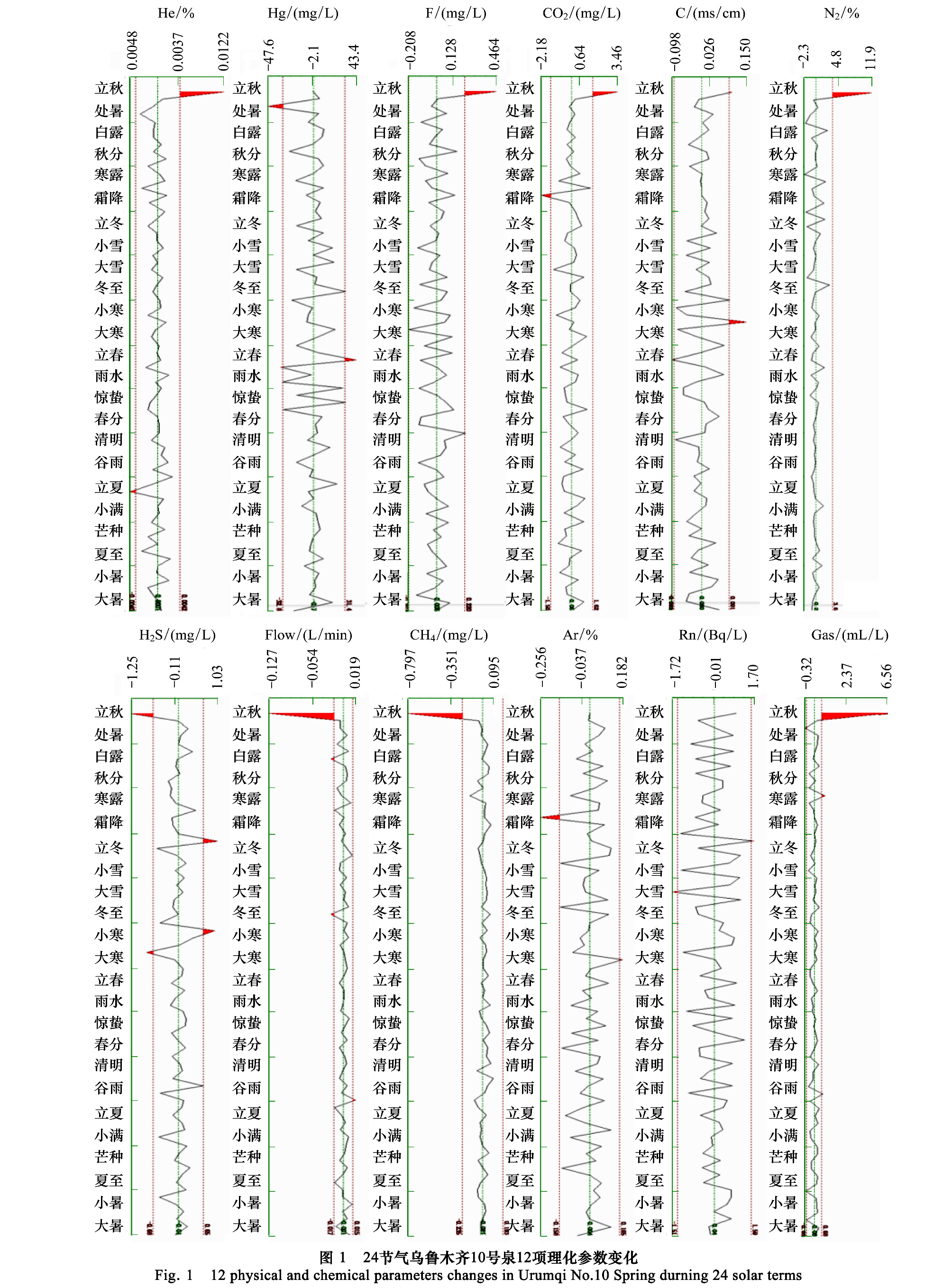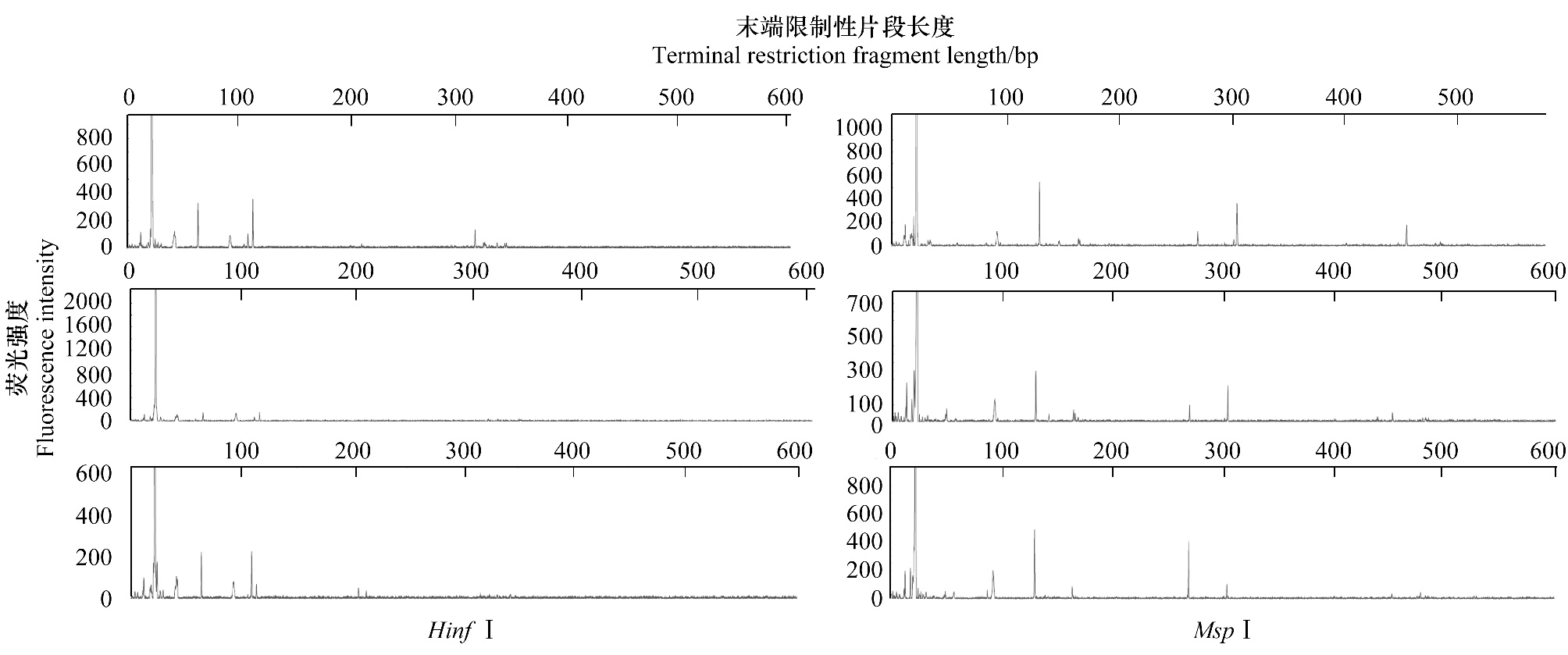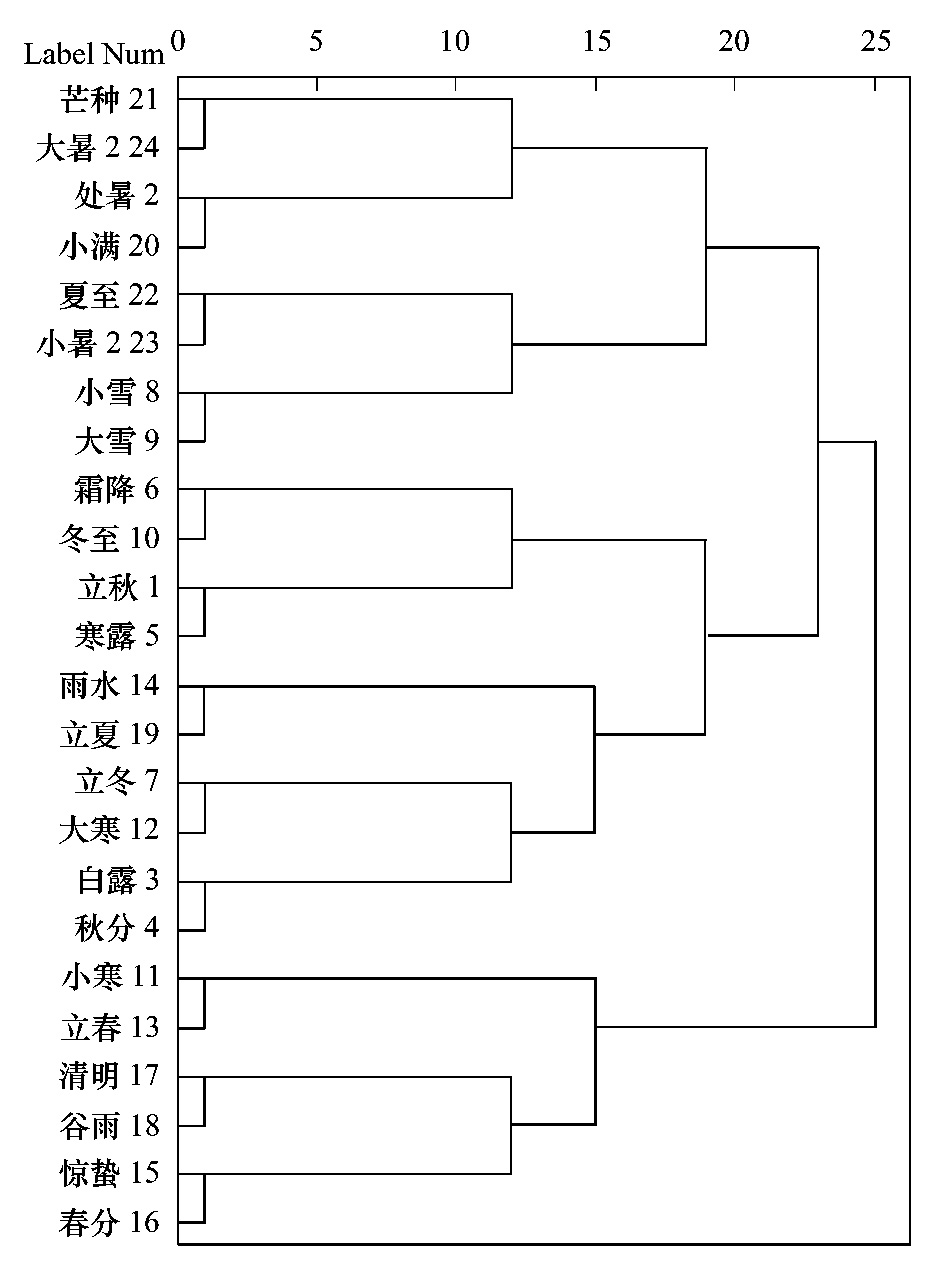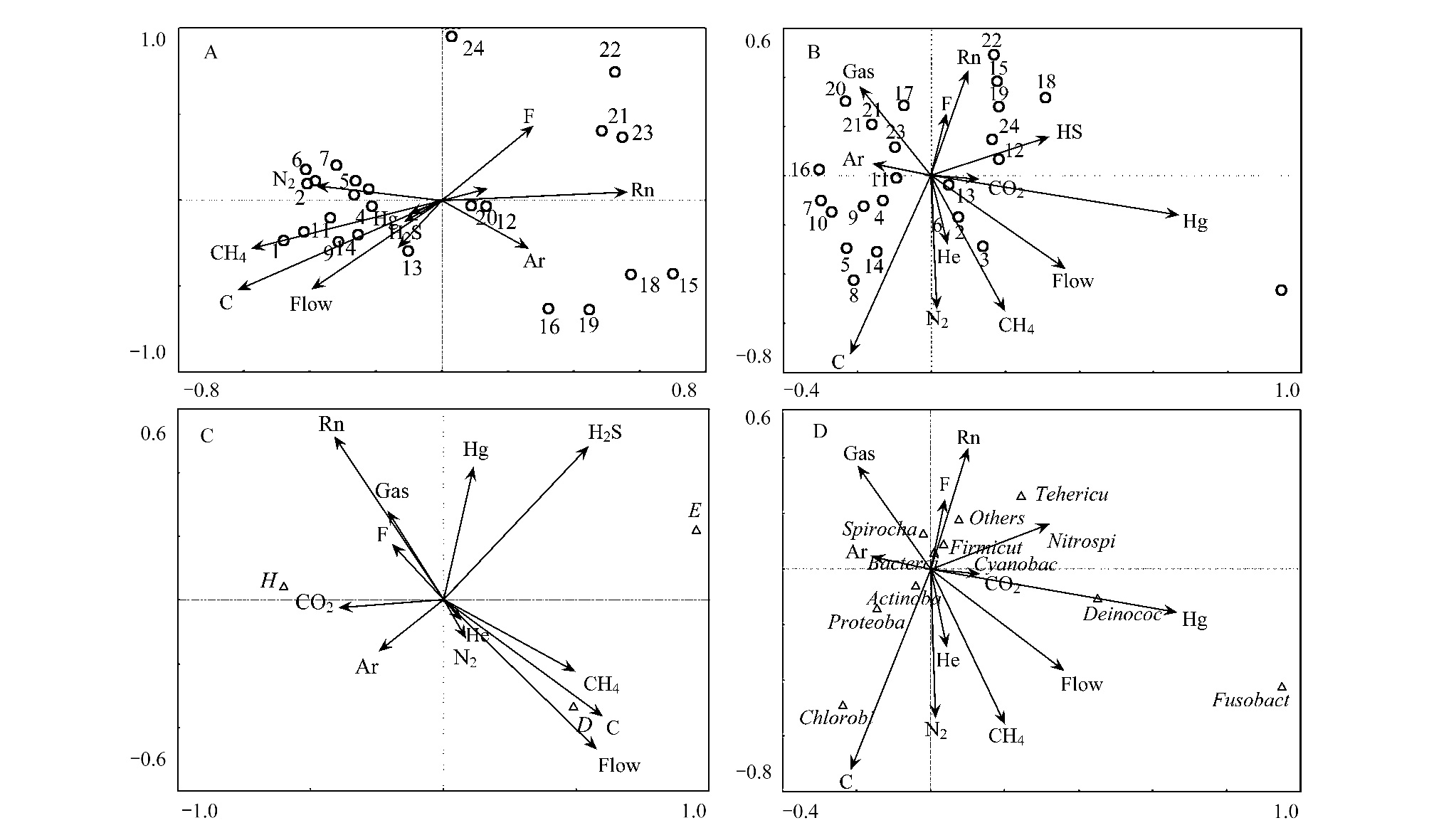文章信息
- 薛娟, 张涛, 曾军, 李萍, 高小其, 娄恺
- XUE Juan, ZHANG Tao, ZENG Jun, LI Ping, GAO Xiaoqi, LOU Kai
- 24节气内乌鲁木齐10号泉水体细菌群落结构变化
- Structure changes of bacteria community in 24 solar terms at No.10 spring Urumqi
- 生态学报, 2014, 34(21): 6214-6224
- Acta Ecologica Sinica, 2014, 34(21): 6214-6224
- http://dx.doi.org/10.5846/stxb201301310205
-
文章历史
- 收稿日期:2013-1-31
- 网络出版日期:2014-3-13
2. 石河子大学生命科学学院, 石河子 832000;
3. 新疆大学生命科学与技术学院, 乌鲁木齐 830046;
4. 新疆维吾尔自治区地震局, 乌鲁木齐 830011
2. College of Life Science, Shihezi University, Shihezi 832000, China;
3. College of Life Science and Technology, Xinjiang University, Urumqi 830046, China;
4. Seismological Bareau of Xinjiang Uygur Autonomous Region, Urumqi 830011, China
乌鲁木齐10号泉,为国家基本水化一类台,位于乌鲁木齐南部柳树沟—红雁池断裂带(E 87°37′,N 43°42′) 上。泉水硫化物气味强烈,pH值为7.7,全年水温为11.0 ℃左右,为HCO3-SO4-Cl-Na型弱碱性矿化水[1]。目前,该泉是新疆维吾尔自治区最重要的地下流体综合观测泉,也是中国新疆与哈萨克斯坦交换地下流体资料的监测泉点之一[2]。
目前对24节气的相关研究主要集中在植物物候[3, 4, 5, 6]、动物物候[7]及气候调查[8, 9, 10]方面,对于微生物群落的物候变化,国内相关研究较少[11, 12]。在含硫冷泉微生物方面,Nancy[13]、Anita[14]、Susanne[15]及Christian[16]等人借助不同的手段分别对加拿大极地冷泉、密歇根州硫化泉、加拿大硫化物冷泉和德国冷泉进行了研究,结果发现:硫化物对维持微生物群落稳定有重要作用,含硫冷泉内细菌大部分属于变形菌门,硫化物氧化细菌、蓝细菌等为其主要的优势类群。而针对含硫冷泉水体微生物群落的物候变化的研究,尚未见相关文献报道。
对乌鲁木齐10号泉的研究主要集中于地震分析[17, 18, 19]和水体微生物群落结构方面[20, 21, 22, 23, 24],而水体细菌群落在24节气内的组成及结构上是否存在差异,群落变化是否存在物候现象及细菌群落与地球水文化学参数间的响应关系尚不清楚。本研究采用T-RFLP技术对乌鲁木齐10号泉水体细菌在24节气内群落结构组成及多样性的变化,以及与地球水文化学元素之间的关系进行了研究,以期通过研究,为后续的微生物映震提供细菌群落组成的背景参考。
1 材料与方法 1.1 样品采集及预处理2011年8月3日至2012年7月27日的1a周期内,于每节气当天采集泉水样品3 L,采样后4 h内低温运回实验室[25]。所有采集的泉水样品经0.22 um微孔滤膜过滤,再用10 mL GTE buffer进行洗脱,用于后续DNA提取。
1.2 泉水12项理化指标测定对24节气时所采集的泉水样品中的氟(F-)、硫化物(HS-)、水汞(Hg)、氡(Rn)、氦(He)、氩(Ar)、氮(N2)、甲烷(CH4)、二氧化碳(CO2)、流量(Flow)、电导率(C)和气体总量(Gas)等12项水文化学参数进行测定[26],并利用基于GIS的地震分析预报系统(Mapsis 2.8.5)绘制理化参数波动折线图。
1.3 样品总DNA提取泉水中微生物总DNA的提取参照Shaheen等的方法[27],并根据泉水样品自身的特点稍作改进。取800 μL GTE 洗脱液,加入溶菌酶(10 mg /mL)30 μL 至终浓度为10 mg /mL,37 ℃水浴2 h;加入蛋白酶K(20 mg /mL)10 μL 至终浓度为0. 2 mg /mL,20% 的SDS 17 μL和5 mol /L的NaCl 10 μL,53℃水浴2 h;等体积的酚 ∶ 氯仿 ∶ 异戊醇(25 ∶ 24 ∶ 1) 抽提,离心取上清,再加入2 /3体积的氯仿抽提,离心取上清,加入0. 6 倍的异丙醇,4 ℃过夜;离心弃上清,用预冷的70% 乙醇清洗1 次,倒置凉干;加入20 μL TE 缓冲液,-20 ℃保存。
1.4 16S rDNA 片段扩增利用细菌通用引物8F(5′-FAM-AGAGTTTGAT CCTGGCTCAG-3′)和926R(5′-CCGTCA ATTCCTTTR AGTTT-3′)[28](Sangon,上海)对细菌16S rDNA片段进行PCR扩增。扩增体系如下:预混Premix 15 μL,上下游引物各0.25 μL,10倍稀释的DNA模板0.5 μL,Taq polymerase 0.05 μL,加dd H2O至体系为30 μL。
PCR扩增采用降落PCR,程序为:预变性95 ℃ 6 min,95 ℃ 45 s,61 ℃ 45 s,72 ℃ 90 s,扩增10个循环,每个循环递减0.5 ℃;95 ℃ 45 s,56 ℃ 45 s,72 ℃ 90 s,扩增20个循环,72 ℃延伸10 min,共计30个循环。 以无菌水为空白作为阴性对照。扩增结束后,产物用1%的琼脂糖凝胶进行含量及特异性检测。
1.5 细菌T-RFLP分析利用HinfⅠ(Takara,大连)和MspⅠ(Takara,大连)两种限制性内切酶对PCR产物进行酶切,酶切体系根据说明书略作调整。HinfⅠ和MspⅠ酶切条件为37 ℃酶切10 h,酶切完毕后65 ℃水浴20 min终止反应。酶切产物利用2.5%的琼脂糖凝胶进行酶切效果检测。酶切产物遮光送上海基康生物技术有限公司检测,使用ABI 3730测序仪扫描,用Peak Scanner Software V1.0分析结果。
1.6 数据统计分析选择末端限制性片段大小在50—900 bp之间,荧光强度大于50 FU且目的片段的峰面积比大于总峰面积0.5%(小于0.5%被认为是噪音)的片段进行多样性分析。分别计算各样品的香农指数(Shannon-Weiner index H)、辛普森指数(Simpson index D)和均匀度指数(Evenness index E)[29]。利用Mica PAT+在线数据库(http://mica.ibest.uidaho.edu/)比对分析各T-RFs片段所代表的细菌种属,并将峰面积比大于4%的种属确定为优势类群[30]。分别对HinfⅠ和MspⅠ酶切片段进行比对,挑出共有种属,确定为该环境条件下所拥有的细菌群落。选用SPSS18.0进行样品系统聚类分析;借助CANOCO软件,分析泉水细菌群落组成与12项水文化学参数之间的相关性。
2 结果与分析 2.1 泉水理化指标波动式变化理化指标分析显示,在24节气内,各项指标均围绕背景值呈现出不同程度的上下波动(图 1),其中,氮、氡、氟、流量和气体总量的波动较为平缓,氩、二氧化碳、甲烷、氦等4项参数出现了低于背景值的波动,硫化物、水汞和电导率等指标则出现了显著高于背景值的明显波动。

|
| 图 1 24节气乌鲁木齐10号泉12项理化参数变化 Fig. 1 12 physical and chemical parameters changes in Urumqi No.10 Spring during 24 solar terms |
共获得T-RFLP指纹图谱48个,根据Hinf Ⅰ和Msp Ⅰ酶切T-RFLP图谱(图 2)中T-RFs数目及相对峰高和峰面积值,分别计算了24个样品香农指数(H),辛普森指数(D)、均匀度指数(E)(图 3)。结果显示,Msp Ⅰ酶切样品微生物多样性高于Hinf Ⅰ酶切,故后续分析采用Msp Ⅰ酶切结果。

|
| 图 2 部分样品的T-RFLP酶切图谱 Fig. 2 parts of the sample T-RFLP restriction map |

|
| 图 3 Msp Ⅰ 酶切各项指数的变化 Fig. 3 the index variation by Msp Ⅰ digeste |
各项指数中,香农指数(H)变化幅度较大(1.088—3.003),春季(立春至谷雨)样品呈现出明显的波动趋势,并在惊蛰时达到最低值(1.088),夏季(立夏至大暑) 和秋季(立秋至霜降)样品在节气内呈现类似的递增趋势,冬季(立冬至大寒)样品则保持在较低水平(≈1.761),且夏季样品的香农指数明显高于冬季。此外,辛普森指数(D)和均匀度指数变化较为平缓(E)。惊蛰时期样品的三项指数均最低。
2.3 样品聚类分析对24节气样品进行质心法聚类分析显示(图 4):芒种、大暑、处暑与小满等夏季样品,霜降、冬至、立秋与寒露等秋季样品,小寒、立春、清明、谷雨、惊蛰与春分等春季样品分别聚为一支;夏至与小暑、大雪与小雪、白露与秋分、清明与谷雨、惊蛰与春分等相邻节气聚为一支;芒种与大暑、处暑与小满、立秋与寒露、小寒与立春等相距较近的节气聚在一起。

|
| 图 4 24节气乌鲁木齐10号泉细菌群落聚类图(1—24为采样日期) Fig. 4 Dendrogram of the hierarchical clustering analysis of bacterial community in Urumqi No.10 Spring durning 24 solar terms(1—24 are sampling date) |
经Mica数据库比对(表 1,表 2),24节气内所有细菌群落主要隶属于11个门,其中,放线菌门,拟杆菌门、厚壁菌门、梭杆菌门和变形菌门的含量较高,占总体的75%以上。以上5门按其含量作折线图(图 5),拟杆菌门和变形菌门在24节气内呈现出较为一致的含量波动;秋冬季节,变形菌门在群落中的含量最高,春夏季节,拟杆菌门在群落中的含量最高;秋冬季节各节气中放线菌门和其他类群与厚壁菌门呈现出相似的波动规律;春夏季节内的各节气又与拟杆菌门呈现出相似的波动规律;24节气中厚壁菌门含量的波动始终与拟杆菌门等呈现出相反的趋势,即:拟杆菌门含量最高时,厚壁菌门含量最低。
| 门 Phylum | 节气Solar term | |||||||
| 立秋 Beginning of Autumn | 处暑 End of Heat | 白露 White Dew | 秋分 Autumnal Equinox | 寒露 Cold Dew | 霜降 Frost′s Descent | 立冬 Beginning of Winter | 小雪 Slight Snow | |
| 放线菌门Actinobacteria | 0.2056 | - | 0.3335 | 0.3769 | 0.1996 | 0.1639 | 0.1481 | - |
| 拟杆菌门Bacteroidetes | 0.1012 | 0.422 | 0.3679 | 0.1106 | 0.1337 | 0.4205 | 0.0766 | 0.4464 |
| 厚壁菌门Firmicutes | 0.2643 | 0.289 | - | 0.0251 | 0.1896 | 0.0697 | 0.2971 | - |
| 变形菌门Proteobacteria | - | 0.289 | 0.2223 | 0.3266 | 0.4071 | 0.2764 | 0.4154 | 0.5536 |
| 梭杆菌门Fusobacteria | 0.2863 | - | - | 0.0251 | 0.0018 | 0.0038 | - | - |
| 蓝藻门Cyanobacteria | - | - | - | - | 0.0063 | 0.0035 | - | - |
| 异常球菌-栖热菌门 Deinococcus-Thermus | 0.0242 | - | - | - | - | 0.0026 | 0.0086 | - |
| 螺旋体门Spirochaetes | - | - | - | - | 0.0265 | - | - | - |
| 硝化螺菌门Nitrospirae | - | - | - | - | - | - | - | - |
| 绿菌门Chlorobi | - | - | - | - | - | - | - | - |
| 柔膜菌门Tenericutes | - | - | - | - | - | - | - | - |
| 其他Others | 0.1184 | - | 0.0764 | 0.1357 | 0.0353 | 0.0595 | 0.0544 | - |
| 门 Phylum | ||||||||
| 节气Solar term | ||||||||
| 大雪 Great Snow | 冬至 Inter Solstice | 小寒 Slight Cold | 大寒 Great Cold | 立春 Beginning of Spring | 雨水 Rain Water | 惊蛰 Waking of Insects | 春分 Spring Equinox | |
| 放线菌门Actinobacteria | 0.2119 | 0.1138 | 0.1513 | 0.0746 | 0.224 | 0.1174 | 0.0952 | 0.1698 |
| 拟杆菌门Bacteroidetes | 0.2308 | 0.2194 | 0.2148 | 0.4353 | 0.2481 | 0.3417 | 0.3706 | 0.4834 |
| 厚壁菌门Firmicutes | 0.1482 | 0.1484 | 0.243 | 0.2128 | 0.1734 | 0.1056 | 0.1621 | 0.0848 |
| 变形菌门Proteobacteria | 0.2572 | 0.4203 | 0.24 | 0.1922 | 0.1812 | 0.3026 | 0.1406 | 0.244 |
| 梭杆菌门Fusobacteria | 0.0121 | 0.0045 | 0.0152 | - | 0.0214 | 0.0033 | 0.0034 | 0.0041 |
| 蓝藻门Cyanobacteria | - | - | - | - | - | 0.0345 | - | - |
| 异常球菌-栖热菌门 Deinococcus-Thermus | - | 0.0021 | - | - | - | - | 0.0102 | 0.0103 |
| 螺旋体门Spirochaetes | 0.0121 | 0.015 | - | - | - | 0.0094 | 0.0525 | - |
| 硝化螺菌门Nitrospirae | - | - | - | 0.0025 | - | - | - | - |
| 绿菌门Chlorobi | - | - | - | - | - | 0.0031 | - | - |
| 柔膜菌门Tenericutes | - | - | - | - | - | 0.0025 | - | - |
| 其他Others | 0.1276 | 0.0765 | 0.1357 | 0.0826 | 0.1519 | 0.0799 | 0.1653 | 0.0037 |
| 门 Phylum | ||||||||
| 节气Solar term | ||||||||
| 清明 Pure Brightness | 谷雨 Grain Rain | 立夏 Beginning of Summer | 小满 Grain Full | 芒种 Grain in Ear | 夏至 Summer Solstice | 小暑 Slight Heat | 大暑 Great Heat | |
| 放线菌门Actinobacteria | 0.0561 | 0.0742 | 0.0495 | 0.2734 | 0.3114 | 0.0203 | 0.0893 | 0.0708 |
| 拟杆菌门Bacteroidetes | 0.2678 | 0.5182 | 0.3406 | 0.2763 | 0.4511 | 0.4549 | - | 0.319 |
| 厚壁菌门Firmicutes | 0.3542 | 0.0742 | 0.2395 | 0.2414 | 0.012 | 0.2445 | 0.5022 | 0.2239 |
| 变形菌门Proteobacteria | 0.1719 | 0.0742 | 0.1491 | 0.0532 | - | 0.0305 | 0.2714 | 0.2592 |
| 梭杆菌门Fusobacteria | 0.0088 | - | 0.0109 | 0.0088 | - | 0.0223 | 0.0065 | 0.0067 |
| 蓝藻门Cyanobacteria | - | - | 0.021 | - | - | - | - | 0.0434 |
| 异常球菌-栖热菌门 Deinococcus-Thermus | - | - | 0.0064 | - | - | - | - | 0.0119 |
| 螺旋体门Spirochaetes | - | - | 0.0109 | - | - | - | 0.0067 | |
| 硝化螺菌门Nitrospirae | - | - | - | - | - | - | - | |
| 绿菌门Chlorobi | - | - | - | - | - | - | - | |
| 柔膜菌门Tenericutes | - | - | 0.0129 | - | - | - | - | 0.0452 |
| 其 他Others | 0.1411 | 0.2591 | 0.1593 | 0.147 | 0.2255 | 0.2274 | 0.1306 | 0.056 |
| 类群 Groups | 门Phylum | 属Genus | 荧光片段T-RFs |
| 优势类群Dominant Community | Actinobacteria | Arthrobacter | 165 |
| Corynebacterium | 165 | ||
| Frankia | 130 | ||
| Nocardioides | 130 | ||
| Streptomyces | 130/165 | ||
| Bacteroidetes | Flavobacterium | 84/93/485 | |
| Flexibacter | 93 | ||
| Firmicutes | Bacillus | 53/130/145/165 | |
| Clostridium | 93/165/485 | ||
| Eubacterium | 270/485 | ||
| Paenibacillus | 130 | ||
| Proteobacteria | Acidithiobacillus | 165 | |
| Acidiphilium | 441 | ||
| Geobacter | 130 | ||
| Thiothrix | 130 | ||
| Fusobacteria | Leptotrichia | 165 | |
| Others | Olavius | 165 | |
| 特殊类群Particular Community | Actinobacteria | Microbacterium | 165 |
| Mycobacterium | 165 | ||
| Bacteroidetes | Capnocytophaga | 84 | |
| Cytophaga | 84 | ||
| Microscilla | 93 | ||
| Proteobacteria | Achromatium | 455 | |
| Azoarcus | 84 | ||
| Azospirillum | 130/165 | ||
| Caulobacter | 130 | ||
| Desulfatiferula | 165 | ||
| Desulfobacter | 165 | ||
| Desulfofrigus | 165 | ||
| Stenotrophomonas | 455 | ||
| Spirochaetes | Treponema | 165/305 | |
| Cyanobacteria | Synechococcus | 130 | |
| Cylindrospermopsis | 148 | ||
| Chlorobi | Chlorobiaceae 某属 | 127 | |
| Prosthecochloris | 127 | ||
| Deinococcus-Thermus | Deinococcus | 270 | |
| Nitrospirae | Leptospirillum | 80 | |
| Tenericutes | Phytoplasma | 212 |

|
| 图 5 细菌优势门在24节气内的含量变化 Fig. 5 Dominant Community composition in 24 solar terms |
进一步分析各片段所代表的细菌类群,优势类群包括放线菌门的Arthrobacter、Corynebacterium、Frankia、Nocardioides和Streptomyces代表片段为130 bp和165 bp;拟杆菌门的Flavobacterium和Flexibacter,代表片段为84 bp和93 bp,厚壁菌门的Bacillus、Clostridium、Eubacterium和Paenibacillus代表片段为130 bp、165 bp、270 bp和485 bp;变形菌门的Acidithiobacillus、Acidiphilium、Caulobacter和Thiothrix代表片段有130 bp和165 bp;梭杆菌门的Leptotrichia,代表片段为165 bp;以及普遍存在于大部分样品中的暂定名类群(Candidatus),他们的代表片段为130 bp和165 bp。
特殊类群指仅在某些特定季节或节气中出现,且含量较少的类群,包括放线菌门的Microbacterium和Mycobacterium,代表片段为84 bp和165 bp;拟杆菌门的Capnocytophaga、 Cytophaga和Microscilla,代表片段为84 bp和93 bp;变形菌门的Achromatium、Acidiphilium、Azoarcus、Azospirillum、Desulfatiferula、Desulfobacter、Desulfofrigus 和Stenotrophomonas,代表片段有84 bp、130 bp、165 bp、441 bp和455 bp;异常球菌-栖热菌门的Deinococcus,代表片段为270bp;蓝藻门的Synechococcus和Cylindrospermopsis,代表片段为130 bp和148 bp;螺旋体门的Treponema,代表片段为305 bp,硝化螺菌门的Leptospirillum,代表片段为80 bp;绿菌门的绿菌科某属和Prosthecochloris,代表片段为127 bp以及柔膜菌门的Phytoplasma,代表片段为212 bp。
2.5 细菌群落与12项水文化学参数的CCA分析24节气样品基于T-RFs片段大小(图 6-A)和细菌门含量(图 6-B)与12项水文化学参数的CCA分析显示,电导率、甲烷、流量和氡等对细菌群落的分布影响较大。两种排序方式均显示群落组成有明显的聚集现象,主要可以分为两类。第一类:春夏季节内节气为主的细菌群落组成与氟、氡等具有较高的相关性;第二类:秋冬季节内节气为主的细菌群落组成与电导率等具有较高的相关性。其中,甲烷对秋季各节气细菌群落的影响较为显著。

|
| 图 6 24节气(A、B)、多样性(C)、细菌群落(D)与乌鲁木齐10号泉理化参数的典型相关性分析 Fig. 6 Canonical correspondence analysis between bacterial community (A、B)、 diversity(C)、dominant genus(D)parameters of the No. 10 spring |
通过对样品群落多样性与泉水理化参数的CCA分析发现(图 6-C),24节气泉水细菌群落多样性与环境因子存在明显相关性。其中,氡、甲烷、流量、硫化物、电导率等因子对群落多样性的影响较大,均匀度指数(E)受环境影响相对较小,香农指数(H)与二氧化碳的含量变化呈显著正相关,辛普森指数(D)与流量、甲烷及电导率呈显著正相关,与氡呈显著负相关。
根据24节气细菌群落的门组成与12项水文化学参数在CCA轴上的分布(图 6-D),拟杆菌门、厚壁菌门和其他类群受氟和氡的影响最大;放线菌门、变形菌门和绿菌门受电导率影响较大;蓝藻门、异常球菌-栖热菌门和硝化螺菌门分别受到二氧化碳、水汞和硫化物的影响较大;12项水化参数对梭杆菌门的影响较小。
3 讨论通过对乌鲁木齐10号泉水体细菌群落香农指数、辛普森指数及均匀度指数的计算和分析发现,24节气内,水体细菌群落呈现出秋升冬降春波动夏回升的趋势,且夏季的各项指数明显高于冬季。乌鲁木齐10号泉水温年变化甚微[2],故判断温度对出现此变化趋势的影响较小。分析原因可能为:(1)虽然10号泉属寡营养环境,但随着季节更替,外界环境温度的逐渐回升,泉区东南方的博格达山区大气降水与高山积雪融水的补给增多,泉水径流量增加,导致水体营养成分有所变化所致;(2)乌鲁木齐10号泉处于地震断裂带上,受地球内部活动的影响,细菌群落可能对氡、甲烷、流量、硫化物、电导率等地球水文化学因子产生得响应所致;(3)物候现象可对微生物群落产生影响所致。
细菌群落结构组成的分析表明:该环境下的微生物群落有优势类群和随机类群组成。放线菌门、拟杆菌门等5个门中的部分细菌类群(Arthbater,Corynebacterium,Flexibacter,Clostridium,Eubacterium,GeobacterDesulfobacter,Thiothrix等)为该环境下的优势群落,它们随时间、季节变化而稳定存在,对环境具有高度的适应性,这与Farnleitner等人[31]和Pronk等人[32]对不同冷泉系统微生物群落的研究结果相一致。随机类群包括放线菌门、拟杆菌门等5个门中部分随机出现的细菌类群和蓝藻门、异常球菌-栖热菌门等类群,它们在监测期内仅存在于某些特定季节或节气内,其丰度变化并无明显的规律可循,推测可能是受物候影响所致。例如:无色杆菌属(Achromatium)、嗜纤维菌属(Cytophaga)等仅出现在春季的各节气中;冷弯菌属(Psychroflexus)仅见于冬季的节气中;异常球菌属(Deinococcus)仅出现在立秋、立冬、立春和立夏节气附近。此外,群落中存在较为丰富的硫氧化菌类群(Acidithiobacillus、Thiothrix)和硫还原菌类群(Desulfobacter、Desulfoluna),他们共同维持着该环境下的硫循环。
12项水文化学参数对细菌群落影响的分析结果表明,理化参数的变化对10号泉水体细菌群落的多样性有显著影响,其中影响作用较大的因子有甲烷、流量、硫化物、氡及电导率等。乌鲁木齐10号泉中含有的CO2、H2、N2、HS、CH4等可作为潜在的电子供体和受体,它们可为微生物多样性的代谢类型提供可能[13],它们同时影响着泉水的电导率。在CCA排序轴上的排序显示,大部分的样品这几项指标的变化呈正相关,这一结果表明,细菌群落的多样性受多项环境因子的共同作用[33]。24节气样品基于T-RFs和群落组成门含量在CCA轴上的排序均显示春夏季节样品和秋冬季节样品具有差异性,结合5个优势门含量在24节气内的波动变化可知,拟杆菌门和厚壁菌门在含量上呈互补关系,受氟和氡的共同作用,春夏季节的各节气,优势的细菌类群为拟杆菌为代表的革兰氏阴性菌,秋冬季节的各节气,优势类群为厚壁菌为代表的革兰氏阳性菌。革兰氏阳性菌与革兰氏阴性菌相比,细胞壁具有较厚的肽聚糖层,相关研究表明,肽聚糖具有抗新陈代谢活性、免疫调解活性等生物学功能[34],因而细胞壁中肽聚糖含量占干重30%—95%的革兰氏阳性菌[34],可能对恶劣环境具有更高的耐受性。
4 结论乌鲁木齐10号泉水体细菌群落结构和多样性在24节气内的变化明显,水体细菌群落呈现出秋升冬降春波动夏回升的趋势,且夏季的各项指数明显高于冬季,群落多样性受水文化学参数的影响;乌鲁木齐10号泉中稳定存在有放线菌门、拟杆菌门、厚壁菌门、变形菌门及梭杆菌门的某些细菌种属,只是在各节气所占比例略有差别,此外,放线菌门、拟杆菌门、变形菌门、厚壁菌门、蓝藻门、异常球菌-栖热菌门、绿菌门、柔膜菌门、螺旋体门及硝化螺菌门的某些种属存在于特定季节或节气内且含量相对较低;厚壁菌门为代表的革兰氏阳性菌对环境变化具有更好的耐受性。
由于T-RFLP技术的局限性[35],后续可结合克隆文库分析及核酸杂交分析来获得更加详实的信息,为深入研究乌鲁木齐10号泉水体微生物群落奠定更加坚实的基础。
| [1] | Gao X Q, Dilixiati, Xu Q L, Li Y P, Feng X H, Cui Y. An investigation on the characteristics of earthquake-indicating variations of F- in Wulumuqi No 9 and No 10 springs. Journal of Seismology, 2002, 22(1): 5-11. |
| [2] | Gao X Q, Xu Q L, Li Y P, Li X Y, Zhang X M, Cui Y. Reflecting earthquake analysis of discharge rate for the No10 spring spot in Urumqi. Journal of Seismology Research, 2001, 24(3): 233-237. |
| [3] | Wang L X, Chen H L, Li Q, Yu W D. Research advances in plant phenology and climate. Acta Ecologica Sinica, 2010, 30(2): 447-454. |
| [4] | Pei S X, Guo Q S, Xin X B, Hong M, Kang Y. Research on plant phenological responses to climate change abroad. World Forestry Research, 2009, 22(6): 31-37. |
| [5] | Chang Z F, Zhang J H. The achievements, problems and growing point on study of plant phenology. Chinese Agricultural Science Bulletin, 2011, 27(29): 276-283. |
| [6] | Wang B Y, Fan G Z, Dong Y P, Hua W, Zhou D W, Zhu L H, Zhang Q. Climate and phenology variations in Sichuan and Chongqing. Scientia Geographica Sinica, 2011, 31(6): 674-681. |
| [7] | Zhai G M, Li Z G, Wang M T. Analysis of the impact of climate change on the phenology of animals. Journal of Anhui Agricultural Sciences, 2010, 38(18): 9652-9654, 9658-9658. |
| [8] | Zhao H Y, Li X L, Lu C H, Huang L, Wang Y Y, Liu Q. On climate survey by phenological index. Chinese Agricultural Science Bulletin, 2009, 25(24): 480-483. |
| [9] | Li Y N, Tao L X, Zhang D S. Analysis on the climatic characteristics of temperature in"24 solar terms" in Beijing's chaoyang district. Science and Technology Innovation Herald, 2009(20):98,100. |
| [10] | Hou Y H, Lu S, Zhang R. Analysis on the climatic characteristics of temperature in"24 solar terms"in Liaoning Province. Journal of Anhui Agricultural Sciences, 2011, 39(16): 9916-9917, 9992-9992. |
| [11] | Zhang M, Duan H T, Shi X L, Yu Y, Kong F X. Contributions of meteorology to the phenology of cyano-bacterial blooms: implications for future climate change. Water Research, 2012, 46(2): 442-52. |
| [12] | Desprez-Loustau M L, Vitasse Y, Delzon S, Capdevielle X, Marçais B, Kremer A. Are plant pathogen populations adapted for encounter with their host? A case study of phenological synchrony between oak and an obligate fungal parasite along an altitudinal gradient. Journal of Evolutionary Biology, 2010, 23(1): 87-97. |
| [13] | Perreault N N, Greer C W, Andersen D T, Tille S, Lacrampe-Couloume G, Looar B S, Whyte L G. Heterotrophic and autotrophic microbial populations in cold perennial springs of the high arctic. Applied and Environmental Microbiology, 2008, 74(22): 6898-6907. |
| [14] | Chaudhary A, Haack S K, Duris J W, Marsh T L. Bacterial and archaeal phylogenetic diversity of a cold Sulfur-Rich Spring on the shoreline of lake Erie, Michigan. Applied and Environmental Microbiology, 2009, 75(15): 5025-5036. |
| [15] | Susanne D, Dean D D. Structural and geomicrobiological characteristics of a microbial community from a cold sulfide spring. Geomicrobiology Journal, 2001, 18(4): 401-422. |
| [16] | Rudolph C, Wanner G, Huber R. Nature commumities of novel archaea and bacteria growing in cold sulfurous springs with a string-of-pearls-like morphology. Applied and Environmental Microbiology, 2001, 67(5): 2336-2344. |
| [17] | Li Y P, Gao X Q. Analysis on hydrochemistry precursory anomaly in Urumqi before Tuokexun Ms 5.6 earthquake in Xinjiang. Earthquake Research in Plateau, 1999, 11(4): 58-60. |
| [18] | Gao X Q, Lan L, Xu Q L, Li X Y, Cui Y, Li Y P, Dilixiati. Change of He content in spring-water of Urumqi 10th well and corresponding ability to earthquakes. Earthquake Research in Sichuan, 2002, 9(3): 27-31. |
| [19] | Gao X Q, Xu Q L, Wang D, Li Y P, Li X Y, Cui Y. Study on characteristics of source precursor and field precursor of moderately strong earthquake and far-field precursor of strong earthquake swarm in underground fluid-Taking No.10 spring of Urumqi, Xinjiang for example. Earthquake Research in Shanxi, 2002, 4(2): 14-19. |
| [20] | Wu J C, Gao X Q, Zeng J, Xu J H, Yang X F, Lou K. The bacterial community structures in Xinjiang fault belt spring analyzed by PCR-DGGE. Acta Ecologica Sinica, 2011, 31(2): 506-512. |
| [21] | Li H, Zeng J, Gao X Q, Zhang T, Yang X F, Sun J, Lou K. Dynamic changes of bacteria community structure in a sulfur cold spring in Xinjiang fault zone. Xinjiang Agricultural Sciences, 2011, 48(4): 724-727. |
| [22] | Li H, Zeng J, Gao X Q, Yang H M, Zhang T, Yang X F, Sun J, Lou K. Bacterial community structure and diversity in a cold sulfur spring in Xinjiang faulting zone. Acta Microbiologica Sinica, 2011, 51(5): 595-602. |
| [23] | Wu J C, Zhang T, Sun J, Shi Y W. Functional diversity of microbial community in seismic fault belt spring of Xinjiang. Xinjiang Agricultural Sciences, 2010, 47(5): 1052-1056. |
| [24] | Zhang Q, Li S, Zeng J, Gao X Q, Yang X F, Lou K. Preliminary analysis on dynamic change of bacterial community and its respond pattern in the No.10 Spring of Urumqi in Xinjiang. Xinjiang Agricultural Sciences, 2012, 49(3): 496-501. |
| [25] | Industry standard of geology and mineral resources of the people 's republic of China. Method of underground water quality testing. DZ/T 0064.2-1993. |
| [26] | Gao X Q, Xu Q L, Zhang X M, Li Y P, Lu J F, Cui Y. Preliminary analysis on synthetic fluid observation of Urumqi spring No.10 and its earthquake-reflecting sensitivity. Inland Earthquake, 2000, 14(3): 243-251. |
| [27] | Humayoun S B, Bano N, Hollibaugh J T. Depth distribution of microbial diversity in Mono Lake, a meromictic soda Lake in California. Applied and Environmental Microbiology, 2003, 69(2): 1030-1042. |
| [28] | Liu W T, Marsh T L, Cheng H, Forney L J. Characterization of microbial diversity by determining Terminal Restriction Fragment Length Polymorphisms of genes encoding 16S rRNA. Applied and Environmental Microbiology, 1997, 63(11): 4516-4522. |
| [29] | Li L B, Liu M, Yang S Z, Liu L, Miao K, Yang K, Han J G. Cultivable microbial diversity at the rhizosphere of Phyllostachys pubescens. Acta Microbiologica Sinica, 2008, 48(6): 772-779. |
| [30] | Ringelberg D B, Foley K L, Reynolds C M. Electrogenic capacity and community composition of anodic biofilms in soil-based bioelectrochemical systems. Applied Microbiology and Biotechnology, 2011, 90(5): 1805-1815. |
| [31] | Farnleitner A H, Wilhartitz I, Ryzinska G, Kirschner A K T, Stadler H, Burtscher M M, Hornek R, Szewzyk U, Herndl G, Mach R L. Bacterial dynamics in spring water of alpine karst aquifers indicates the presence of stable autochthoNous microbial endokarst communities. Environmental Microbiology, 2005, 7(8): 1248-1259. |
| [32] | Pronk M, Goldscheider N, Zopfi J. Microbial communities in karst groundwater and their potential use for biomonitoring. Hydrogeology Journal, 2009, 17(1): 37-48. |
| [33] | Bartomiej R, Dirk S M. Correlation between microbiological chemical parameters of some populations in petroleum-contaminated groundwater discharged from underground crude oil storage cavities. Applied and Environmental Microbiology, 2000, 66(11):4803-4809. |
| [34] | Liu F, Yang Y H. Research on Peptidoglycan of bacterial cell wall. Journal of Sichuan University of Science and Engineering: Natural Science Edition, 2011, 24(6): 628-631. |
| [35] | Wang X D, Li Y H. Advances in studying water microbial ecology by molecular biological techniques. Microbiology, 2007, 34(4): 777-781. |
| [1] | 高小其, 迪里夏, 许秋龙, 李艳萍, 冯晓晖, 崔勇. 乌鲁木齐9、10号泉F-映震特征的研究. 地震学刊, 2002, 22(1): 5-11. |
| [2] | 高小其, 许秋龙, 李艳萍, 李新勇, 张学敏, 崔勇. 乌鲁木齐10号泉流量的映震分析. 地震研究, 2001, 24(3): 233-237. |
| [3] | 王连喜, 陈怀亮, 李琪, 余卫东. 植物物候与气候研究进展. 生态学报, 2010, 30(2): 447-454. |
| [4] | 裴顺祥, 郭泉水, 辛学兵, 洪明, 康义. 国外植物物候对气候变化响应的研究进展. 世界林业研究, 2009, 22(6): 31-37. |
| [5] | 常兆丰, 张剑挥. 植物物候研究的成就、问题与生长点. 中国农学通报, 2011, 27(29): 276-283. |
| [6] | 王炳赟, 范广洲, 董一平, 华维, 周定文, 朱丽华, 张琪. 川渝地区气候与物候的变化特征分析. 地理科学, 2011, 31(6): 674-681. |
| [7] | 翟贵明, 李振国, 王明涛. 气候变化对动物物候的影响分析. 安徽农业科学, 2010, 38(18): 9652-9654, 9658-9658. |
| [8] | 赵海英, 栗锡龄, 陆春花, 黄磊, 王亚英, 柳琼. 用物候指标进行气候调查的初步研究. 中国农学通报, 2009, 25(24): 480-483. |
| [9] | 李耀宁, 陶立新,张德山. 北京市朝阳区“24节气”气温的气候特征分析. 科技创新导报, 2009(20):98,100. |
| [10] | 侯亚红, 路爽, 张蕊. 辽宁省“24节气”气温的气候特征分析. 安徽农业科学, 2011, 39(16): 9916-9917, 9992-9992. |
| [17] | 李艳萍, 高小其. 托克逊Ms5.6级地震前乌鲁木齐水化学前兆异常分析. 高原地震, 1999, 11(4): 58-60. |
| [18] | 高小其, 蓝陵, 许秋龙, 李新勇, 崔勇, 李艳萍, 迪里夏提. 乌鲁木齐10号泉He含量变化的映震特征. 四川地震, 2002, 9(3): 27-31. |
| [19] | 高小其, 许秋龙, 王道, 李艳萍, 李新勇, 崔勇. 地下流体中强震源兆场兆及强震(群)远场兆特征的研究—以新疆乌鲁木齐10号泉为例. 山西地震, 2002, 4(2): 14-19. |
| [20] | 吴江超, 高小其, 曾军, 徐建华, 杨晓芳, 娄恺. 新疆断裂带泉水中细菌群落结构的PCR-DGGE分析. 生态学报, 2011, 31(2): 506-512. |
| [21] | 李慧, 曾军, 高小其, 张涛, 杨晓芳, 孙建, 娄恺. 新疆断裂带含硫冷泉泉水细菌群落结构的动态变化. 新疆农业科学, 2011, 48(4): 724-727. |
| [22] | 李慧, 曾军, 高小其, 杨红梅, 张涛, 杨晓芳, 孙建, 娄恺. 新疆断裂带含硫冷泉泉水细菌群落结构多样性. 微生物学报, 2011, 51(5): 595-602. |
| [23] | 吴江超, 张涛, 孙建, 史应武. 新疆地震断裂带泉水微生物群落功能多样性. 新疆农业科学, 2010, 47(5): 1052-1056. |
| [24] | 张强, 李珊, 曾军, 高小其, 杨晓芳, 娄恺. 乌鲁木齐10号泉水体细菌群落结构的动态变化及响应模式初析. 新疆农业科学, 2012, 49(3): 496-501. |
| [25] | 中华人民共和国地质矿产行业标准. 地下水质检验方法, 水样的采集和保存. DZ/T 0064.2-1993. |
| [26] | 高小其, 许秋龙, 张学敏, 李艳萍, 卢静芳, 崔勇. 乌鲁木齐10 号泉流体综合观测及映震灵敏性初析. 内陆地震, 2000, 14(3): 243-251. |
| [34] | 刘芳, 杨跃寰. 细菌细胞壁肽聚糖的研究. 四川理工学院学报: 自然科学版, 2011, 24(6): 628-631. |
| [35] | 王晓丹, 李艳红. 分子生物学方法在水体微生物生态研究中的应用. 微生物学通报, 2007, 34(4): 777-781. |
 2014, Vol. 34
2014, Vol. 34




